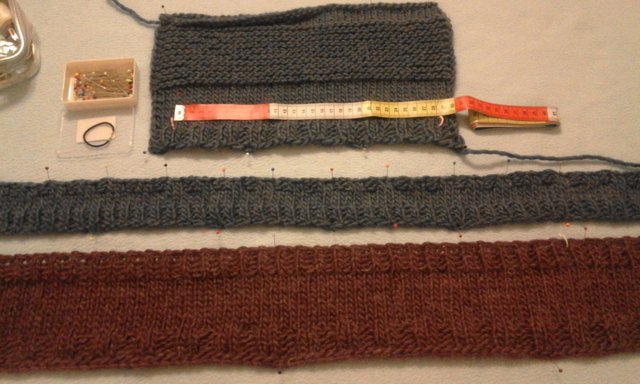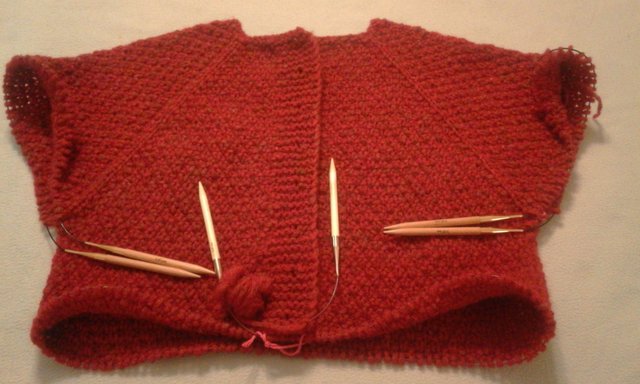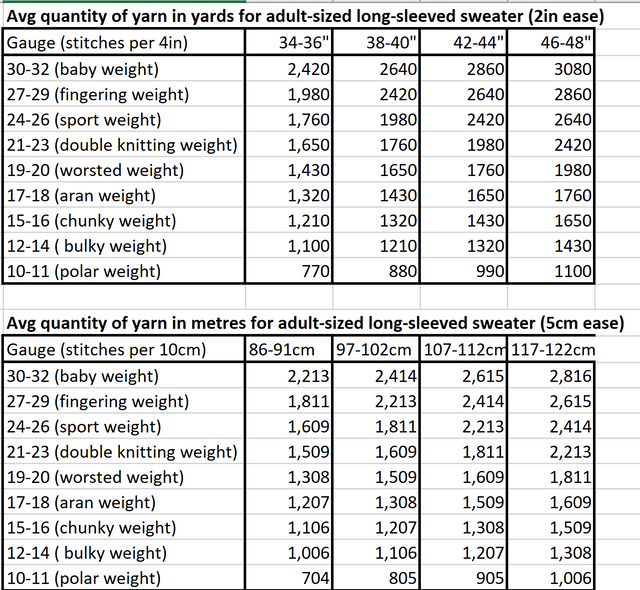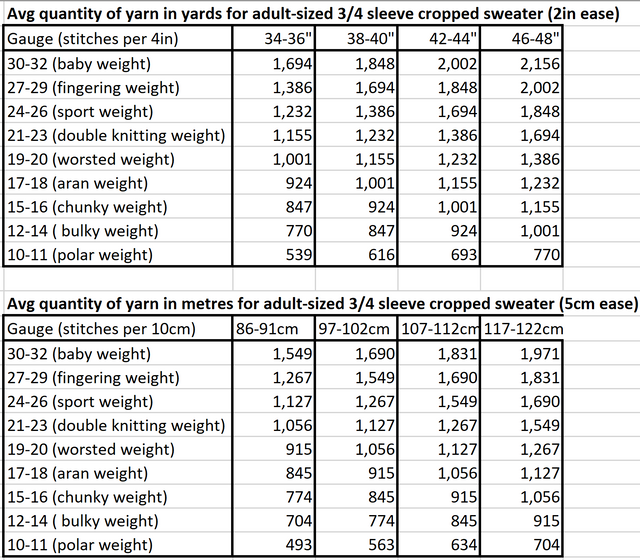#needleworkmonday - swatchtaping :)
I've been making swatches and planning my next two top-down cardigans. Swatching was always one of those aspects of knitting that was shrouded in mystery (how did you make it work and come up with the right number of rows and stitches, as prescribed by the pattern) and a right boring pain to do.
I have always painstakingly made a swatch because, you know, you should but it hasn't really made any difference. I spent hours swatching for a lace cardigan last summer and then many more hours making the cardigan and it was still far too big: big enough for a giant woman!
I've had a little more success more recently, by making much larger swatches - knitting perhaps as much as a ball before checking the gauge - and then knitting another swatch with the revised needles and so on, until I had a close approximation of the desired tension. It did work and my last cardigan was a perfect fit :)

I've started taking a different approach to swatching, making a long "swatch-tape" based on my bust measurement. The swatch is long and thin, has single ribbing (k1, p1) at one edge and double ribbing (k2, p2) at the other edge and about 10cms of stocking stitch in between, using the size and type of needles (eg circulars) and yarn that will be used in the final garment.
In the top swatch, I have checked the number of stitches in one quarter of my bust measurement and then used that to calculate how many stitches I need for the swatch tape. I've also tried garter stitch (nice as a border, but not for the whole garment) and tried out a different neck finish (a rolled stocking stitch) in the sample.
The idea for swatchtaping came from J's Knit and Pearl Jam, which she explains in this video:
J explains her ideas about swatch-tapes - actually using your swatch like a tape measure to check the fit and find out how many stitches you will need. She also talks about how to calculate how many stitches to cast on.
The single and double ribbing at the edges is inspired: it makes it so easy to distinguish your starting and ending stitches and to count the number in between. I can't remember if she says it in this video, but two other things that J stresses are: to stretch your knitting out before you start counting stitches and to round the number of stitches to a number divisible by four.
I've started to really enjoy swatching as an activity in itself, rather than as a necessary evil that didn't seem to serve any purpose. Instead of trying to adapt my natural knitting tension and rhythm to an arbitrary designer's gauge, it's more about finding out what the gauge is if I use the recommended yarn and needles, and then using that to design a garment that fits me. Yay!

Here's the progress with my first top down cardigan. It fits perfectly and feels really comfortable. The neckline looks a little odd here, but sits very nicely when the garment is being worn.
Another tip from J is having multiple sets of circular needles in the same size with different cable lengths. I went out and bought a set with a 150cm cable for the main body - so much easier than keep putting the stitches on to waste yarn to check the fit (which you might want to do every few rows at some stages). You can also work on both sleeves at the same time, avoiding the "I've finished the first sleeve and now I can't bear to do it all again" syndrome.
The other tool I've learned about is the yarn calculator:

Working with stitches to 10cms/4 inches makes it so much easier to calculate average quantities for a sweater or cardigan. For short sleeves: calculate 20% less, for sleeveless: 30% less; for multi-colour garments: 20% more.
I've adapted this for the three-quarter sleeve cropped style that I prefer:

I'm really enjoying "finding my numbers" as J. would say - the basic construction for my size and style of garment. Once I have the numbers, I can start to design patterns.
It's so interesting to see the tables laid out like that, @shanibeer, thank you!
I feel it's essential to swatch when when you are making a garment that also includes the sleeves because it will look really big and I'd personally feel overwhelmed with the number of stitches ! When I knit the sections separately I can 'gauge' as I go along. This is by hand, but when I use my knitting machine I really need to swatch.
I'm glad the tables are useful 😊 I've copied a set into the notebook I carry round with me "just in case" I fall over any yarn while I am out.
I agree - when I got to the longest rows, it was quite difficult managing all those stitches, it was a case of holding my breath and hoping it would all turn out all right when I got through to the next stage. Do you have any machine knitting planned?
😊 @shanibeer, this cheered my 'ill self' up :
I always have 'projects in mind'; I really need to make space around my knitting machine first, but another sweater would be good. I will just make the same sort of 'easy fit' style and fix the details, eg sleeve length :D
Oh, sorry you're poorly! Glad I cheered you up 😀
This was so awesome all written out like this! You made it so easy to understand and wow! swatching looks like the way to go! Thank you for all of these wonderful tips and I am bookmarking this for future reference!
Thank you!!!
!tip
I'm so pleased you found it useful!
It was, by far, one of the most well-written I have ever seen! No kidding!
Those long swatches do give you information a little square just cannot. I will try that before my next sweater. Sometimes I start with a sleeve so I can see how the pattern and yarn will really work together.
Yes, they do ... and they give you a real feel for the beauty of the yarn you are working with.
Starting with a sleeve is a good idea :)
Oh thank you, I just needed this info👌
👍
Congratulations @shanibeer! Your post has been placed in the spotlight for this weeks @NeedleWorkMonday Featured Post!
Thank you for your quality post and for being apart of the needlework community!
#NeedleWorkMonday is an initiative that supports and rewards the needlework community while inspiring the Steemit blockchain. You can read more about us here.
Thank you @needlewokmonday 😊
I love the idea of swatching! This seems it would be great for @neumannsalva to try since she runs into the “too big” problem often with her cardigans. You really shared some valuable tools and great tips! Your cardigan is coming along beautifully ~ 😊
For me, it's about understanding swatching as part of the creative process rather than an unrelated task. Yes, I'm pleased with the cardigan ... and no sewing up!
wow !!!! You wrote a great post! I see how much preliminary work has been done by you. it is already clear that the cardigan looks neat and cozy. Successes to you in continuation of work !!!!!
Thank you, I'm glad you enjoyed it :) Have you settled down after your move? Hope all is well.
Many thanks for the care, dear! Yes, we already got a little comfortable in the city. we like it - the winter climate here in the south of Israel is much milder than in the center of the country. I do not know how it will be in the summer :)))))
Thank you so much for participating the Partiko Delegation Plan Round 1! We really appreciate your support! As part of the delegation benefits, we just gave you a 3.00% upvote! Together, let’s change the world!
🎁 Hi @shanibeer! You have received 0.1 STEEM tip from @dswigle!
@dswigle wrote lately about: Wednesday Walk Feel free to follow @dswigle if you like it :)
Sending tips with @tipU - how to guide :)